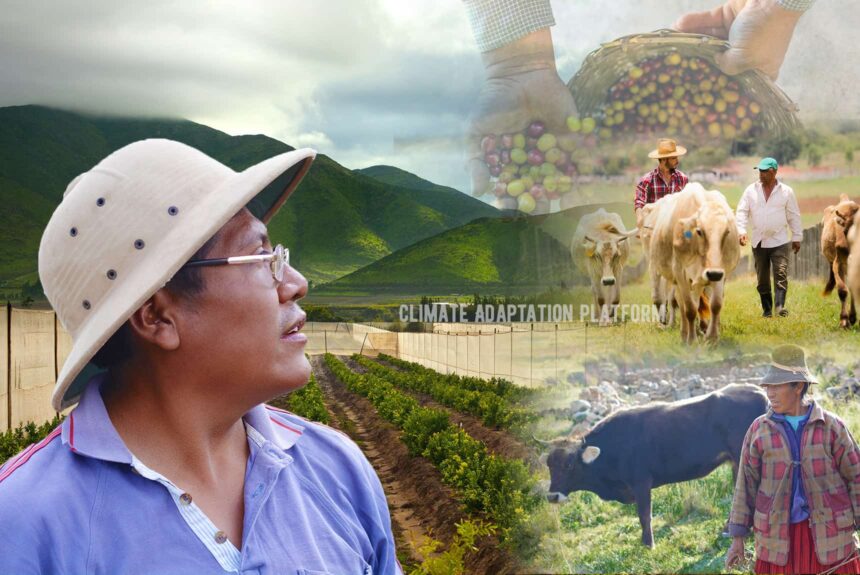Latin America’s climate is changing. Precipitation patterns are shifting, temperatures are rising, and some areas are experiencing changes in the frequency and severity of weather extremes such as heavy rains, hurricanes, hailstorms, tornados, blizzards, heavy snowfall, avalanches, coastal storm surges, floods including flash floods, drought, heatwaves and cold spells. This has resulted in the displacement of people, numerous fatalities and significant economic losses (Climate change impacts, 2021).
The climate crisis is hitting farmers in Latin America, which accounts for 14% of the world’s food production. Its agriculture sector is also facing climate adaptation (Hiba, 2022).
The Dialogo Chino article “How South American agriculture is adapting to climate change” explains how South American farmers are adapting to climate change effects such as rising temperatures, more frequent extreme events, and rainfall patterns.
It mentions the World Meteorological Organization report showing that 2020 was one of the three warmest years on record for Mexico/Central America and the Caribbean and the second warmest year for South America. Temperatures were 1.0 °C, 0.8 °C and 0.6 °C above the 1981–2010 average.
Glaciers in the Chilean and Argentine Andes have been shrinking in the last decades, and the ice mass has accelerated since 2010. Southern Amazonia and the Pantanal have seen the worst droughts in the past 60 years. There have also been more active fires in 2020 than in 2019 in the southern Amazon (Hiba, 2022).
Latin America and the Caribbean region have seen widespread droughts that have affected crop yields, food production, and inland shipping. There has been decreasing rainfall in the Caribbean region while experiencing category four hurricanes.
Hiba (2022) highlights the region’s following climate adaptation initiatives to help farmers become resilient to extreme weather.
Resilient Food is “an initiative that focuses on small-scale, family-run farms for food production in regions vulnerable to climate change in Argentina and Colombia” (Hiba, 2022).
According to the Resilient Food website, the project’s implementation period covered 24 months, from June 2019 to March 2022, and aims to “increase the resilience and adaptation of horticultural and livestock-based food production systems and the livelihoods of rural families in areas of high vulnerability to the negative effects of climate variability and its changes.”
Its beneficiaries include 400 people (50% women) of 200 families belonging to organizations of family farming (Resilient Food, n.d.).
Nanum Mujeres Conectadas project a part of the broader Gran Chaco Proadapt programme. The project “aims to improve connectivity and digital literacy among women in agriculture, and promote their role as agents of change” (Hiba, 2022).
Increasing management capacities and knowledge and taking a “holistic” view of agriculture as an adaptation strategy. In recent years, increases in rainfall have caused groundwater tables to rise, resulting in perioding flooding and waterlogging, affecting soybeans and maize production.
Farmers reviewed unsustainable practices and replaced this with sustainable ones. Farmers have begun using cover crops to combat flooding and waterlogging to improve soil porosity and generate more biomass that sequesters more carbon in the area.
“Climate change is having an increasing impact on the sector’s performance. That is why we are moving from input-based production to process-based production, which adds more management, knowledge and handling,” says Franco Bardeggia, an agronomist. He coordinates a regional programme run by Aapresid (the Argentine Association of Direct Seeding Producers) in the province of Córdoba, in central Argentina. Farmers have been struggling for years in this area with excessive water levels caused by rising groundwater tables (Hiba, 2022).
Experts also recommend that Latin America scale up climate adaptation and resilience projects in the agriculture section – not as an exception but becoming state policies with a broad scope and enhancing structural changes. While pilot projects such as Resilient Food show an alternative and viable farming method, these projects urgently need scaling up to reduce the impacts of climate change.
To know more about the climate change impacts on the agriculture sector in Latin America and the initiatives farmers are taking to combat it, click the links on the “Sources” below.
Sources:
Climate Change Impacts in Latin America. (2021). WWF. Retrieved from https://www.wwfca.org/en/our_work/climate_change_and_energy/climate_change_impacts_la/
Hiba, J. (2022, May 30). How South American agriculture is adapting to climate change. Dialogo Chino. Retrieved from https://dialogochino.net/en/agriculture/54432-how-south-america-agriculture-climate-change-adaptation/
Resilient Food. Euroclimaplus. Retrieved from https://euroclimaplus.org/en/projects-foods/resilient-food
State of the Climate in Latin America and the Caribbean, 2020. (2021). World Meteorological Organization. Retrieved from https://reliefweb.int/attachments/8805ab72-cb01-37c2-bc5f-2abce8b7a783/1272_Statement_LAC_en_big.pdf



Leave a Reply